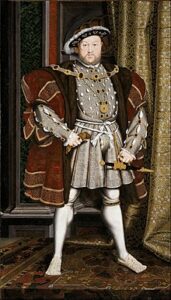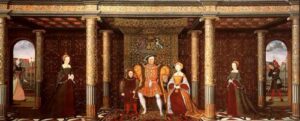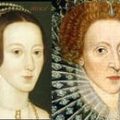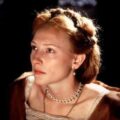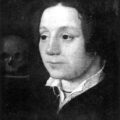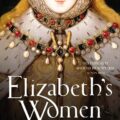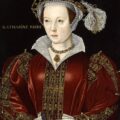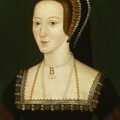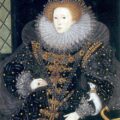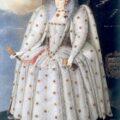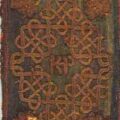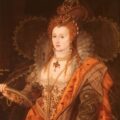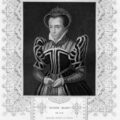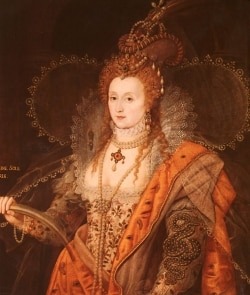
So, why did Elizabeth idolise the man who we now look on as a cruel tyrant and perhaps even a sociopath? A man who executed two of his wives, divorced two, left one to die of childbed fever while he partied (perhaps an exaggeration!) and nearly executed another. A man who neglected her for so long, treated her half-sister with disdain and cruelty, and who is thought to have executed around 72,000 people during his reign. He wasn’t exactly a cuddly teddy bear type of Dad was he? As Anne Boleyn Files and Elizabeth Files visitor Jill Huizenga puts it:-
“I can’t imagine anyone nowadays giving him the Father of the Year award. Can you imagine what his Father’s Day Card would say? “Dear Dad: Happy Father’s Day even though you had my mother put to death, had me declared illegitimate, pitted me against my sister and brother, I’d have to say you did a pretty good job because after all even though I am a female, a lion’s cub I managed to rule for 45 years. Your loving daughter, Elizabeth I.”
That made me chuckle! Thanks, Jill!
But don’t most of us idolise our daddies? Many of us are “Daddy’s girls” and whatever our father’s faults we love them and accept them for who they are – isn’t that what love is all about. OK, so my father didn’t get my mother executed, but Elizabeth would have no memories, or perhaps just hazy ones, of her mother and was never given the chance to have a proper mother/daughter relationship, having been sent to her own household when she was just 3 months old. Her mother would have been a very distant figure and Elizabeth was kept away from all of the court intrigue and scandal, so although it was an awful tragedy, the only impact that Anne’s death may have had on Elizabeth’s life was her demotion from princess to “lady”.
The Father Elizabeth Knew
The Henry VIII we know today is either the majestic, obese and stern Henry of Holbein’s famous portrait or the overly sexed (and sexy!), moody, arrogant and cruel Henry as played by Jonathan Rhys Meyers on “The Tudors”. We don’t know the Henry that Elizabeth knew, we don’t know Henry as a father and that’s why we find it so hard to understand Elizabeth idolising him.
The Henry we think we know was a man who was bitterly disappointed with the birth of his second daughter, but was he really? Tracy Borman, in “Elizabeth’s Women”, makes the point that Henry commented to Anne that they were both young and that they might confidently expect to have sons in the future. He then named his daughter after his beloved mother, Elizabeth of York, and Anne’s mother, Elizabeth Howard. So proud of his baby daughter was Henry that he paraded her naked in front of ambassadors and also celebrated his first wife’s death by parading the 2 year old Elizabeth around the court in his arms, lifting her eye. He obviously delighted in his daughter.
Just months after this show of pride, Elizabeth’s mother was executed for treason, adultery and incest, and it seems that Henry could not bear to see the daughter who would look at him with Anne Boleyn’s coal-black, intelligent eyes. She would be a reminder of all that was bad in his life. However, Tracy Borman writes of how Henry began to take more notice of his second daughter in the late 1530s: “The fact that he now had a male heir no doubt removed some of the resentment he had felt towards her after Anne’s death.” Borman explains that he became very concerned with Elizabeth’s moral development, perhaps because of what happened to her mother, and so he appointed Blanche Parry as her moral guardian, an older woman who would have a better influence on the King’s daughter than her younger predecessors. Alison Weir, in “Elizabeth, the Queen”, writes of how Henry also ensured that Elizabeth received the education of a Renaissance prince.
It was Catherine Parr who is credited with reuniting Henry’s children with their father, and with Elizabeth’s rehabilitation as princess. Unlike her predecessors, Catherine Parr seemed to love all three children and treated them all equally, not showing favour to any one in particular. Alison Weir writes of how, after Henry’s marriage to Catherine Parr, Elizabeth was given her first experience of normal family life (well, royal Tudor life!) as she was welcomed back to court. David Starkey concurs, writing of Elizabeth’s meeting with her father in 1542:-
“All went well. Henry clearly liked what he saw and decided to begin the formal process of Elizabeth’s rehabilitation”
and Elizabeth did not make the mistake of harbouring any resentment against her father for the past, unlike Mary who Starkey writes of having “nailed herself to the cross of her mother’s memory”, but instead delighted in her father’s praise and adoration. As Starkey goes on to say:-
“[Elizabeth] was very much her father’s daughter and he came to reciprocate by taking a warm, fatherly pride in her.”
It seems that the past was forgotten and Henry VIII returned both of his daughter to the succession in 1543.
Alison Weir writes of how this new relationship was nearly wrecked when Elizabeth did something which “incurred her father’s displeasure” and which apparently caused her to go into exile for a year, Borman dismisses this, stating that there is no record of what this disgrace was caused by and also pointing out that Eustace Chapuys, the Imperial Ambassador, makes no mention of it in his letters and reports. Whatever happened, Elizabeth and Mary were both at court for long periods of time between 1543 and their father’s death in 1547. Elizabeth must have been so happy and Starkey describes how she must have felt about Henry:-
“She had a place in the succession, at court and, increasingly, in her father’s affections. She rejoiced in them all, especially the last. Which is why her memory of her father, formed in these few years of the mid 1540s, was so benign: for her, he was not a wife-murdering monster, but a loving parent, formidable ruler and model to which she aspired.”
Elizabeth and her father had much in common and it wasn’t just the Tudor red hair and long nose! Elizabeth was also intelligent, somewhat precocious, and had charm, courage and a strong will. Although she had Anne Boleyn’s eyes, swarthy complexion, long face and pointed chin, Henry must have seen much of himself in her and, as the Venetian Ambassador reported during Mary I’s reign:-
“She also resembles him more than the Queen does; and he therefore always liked her and had her brought up in the same way as the Queen.” (CSPV [Calendar of State Papers, Venetian] VI ii 1059)
Elizabeth’s fondness for her father, and their shared love of learning and theology, is shown in the present she gave him in 1546 – a book of Catherine Parr’s prayers translated into French, Latin and Italian, along with a letter in which she called Henry her “matchless and most benevolent father” and went on to say that she was “not only…an imitator of his virtues but indeed…an inheritor of them.” It does not seem that Elizabeth was just massaging Henry’s ego, but that she truly loved and admired her father. This is apparent when we consider that she “devoured” Henry VIII’s throne speech at Parliament on Christmas Eve 1545 and that she used his ideas, his manner and his phrasing decades later in her speeches as Queen.
The Lion’s Cub
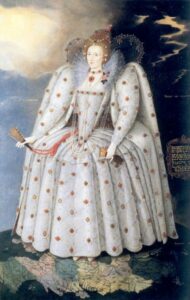
Her father’s influence on her life did not stop when he died or when she became Queen 11 years after his death. At her coronation, on 15th January 1559, Elizabeth showed she had Good King Hal’s magic common touch and Alison Weir writes:-
“Her father had had such a way with him, and one person, seeing the resemblance, cried out “Remember old King Harry the Eighth?” and Elizabeth was seen to smile at this.”
Weir also writes:-
“She was fond of talking about Henry, and even seems to have modelled some of her speeches on his. She liked to remind her councillors how much sterner her father had been…In 1593, she acknowledged her debt to Henry VIII before Parliament, as one “whom in the duty of a child I must regard, and to whom I must acknowledge myself far shallow.””
Tracy Borman agrees, writing:-
“The many references that she made to Henry VIII, and the way in which she tried to emulate his style of monarchy when she became Queen, all support this view.” and
“Her speeches would be littered with references to him as she endeavoured to overcome the weakness of her sex by reminding her people that she was a chip off the old block. She variously referred to herself as “my father’s daughter” or “the lion’s cub””
And David Starkey writes of Elizabeth being Henry VIII’s “daughter, imitator, heir and pupil.”
It is even said that Elizabeth would pose by portraits of the majestic Henry VIII when she welcomed to visitors, just to emphasise the likeness between father and daughter and to remind people of who she was. In one famous speech she said:-
“Although I may not be a lioness, I am a lion’s cub, and inherit many of his qualities.”
It seems that not only did Elizabeth realise that she could overcome her so-called female weakness by calling on the memory of her father and relying on her inherited “masculine” characteristics of authority, courage and shrewdness, but that she could also make use of him as a role model for monarchy. She saw herself as a Prince, not Queen, and as a more tolerant female version of her father. As Starkey says: “like her father, she would bite men’s heads off; unlike him, she would rarely cut them off.”
Her Father’s Daughter
As much as we hate Henry VIII’s tyranny and the way that he treated his wives, we cannot love and admire Elizabeth I without also admiring the man that she revered so much and the man that she emulated. Yes, there was much of Anne Boleyn in Elizabeth, and that was Anne’s wonderful legacy, but there was also a huge amount of Henry in the woman who would not suffer fools gladly and a woman who defeated the Armada and heralded in England’s Golden Age. Perhaps we should look at Henry VIII through Elizabeth’s eyes and see the father that revelled in the precociousness of his daughter and who perhaps did recognise her potential.
Sources
- “Elizabeth” by David Starkey
- “Elizabeth’s Women” by Tracy Borman
- “Elizabeth, the Queen” by Alison Weir
